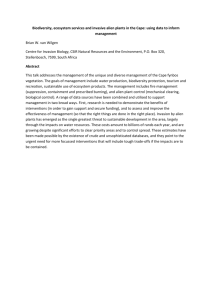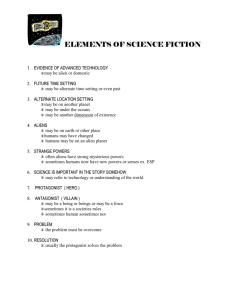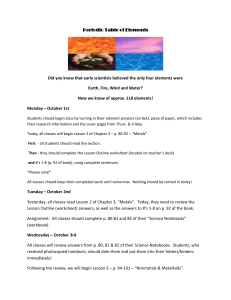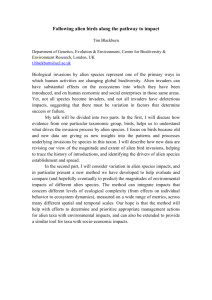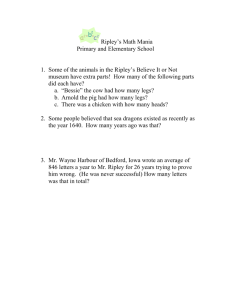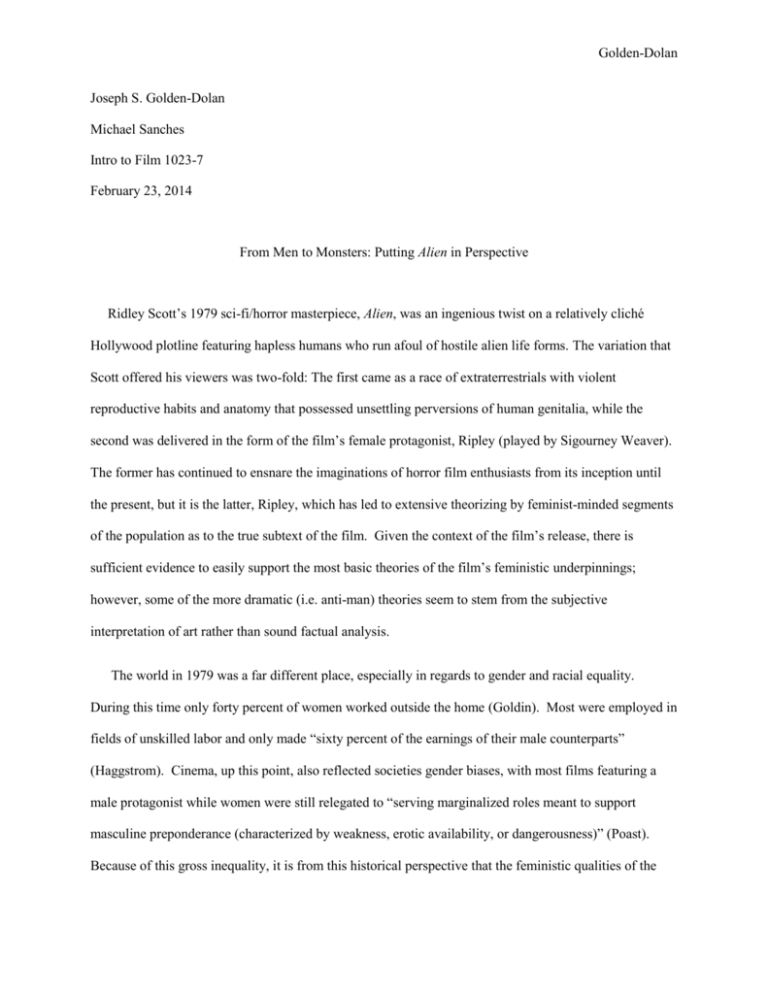
Golden-Dolan
Joseph S. Golden-Dolan
Michael Sanches
Intro to Film 1023-7
February 23, 2014
From Men to Monsters: Putting Alien in Perspective
Ridley Scott’s 1979 sci-fi/horror masterpiece, Alien, was an ingenious twist on a relatively cliché
Hollywood plotline featuring hapless humans who run afoul of hostile alien life forms. The variation that
Scott offered his viewers was two-fold: The first came as a race of extraterrestrials with violent
reproductive habits and anatomy that possessed unsettling perversions of human genitalia, while the
second was delivered in the form of the film’s female protagonist, Ripley (played by Sigourney Weaver).
The former has continued to ensnare the imaginations of horror film enthusiasts from its inception until
the present, but it is the latter, Ripley, which has led to extensive theorizing by feminist-minded segments
of the population as to the true subtext of the film. Given the context of the film’s release, there is
sufficient evidence to easily support the most basic theories of the film’s feministic underpinnings;
however, some of the more dramatic (i.e. anti-man) theories seem to stem from the subjective
interpretation of art rather than sound factual analysis.
The world in 1979 was a far different place, especially in regards to gender and racial equality.
During this time only forty percent of women worked outside the home (Goldin). Most were employed in
fields of unskilled labor and only made “sixty percent of the earnings of their male counterparts”
(Haggstrom). Cinema, up this point, also reflected societies gender biases, with most films featuring a
male protagonist while women were still relegated to “serving marginalized roles meant to support
masculine preponderance (characterized by weakness, erotic availability, or dangerousness)” (Poast).
Because of this gross inequality, it is from this historical perspective that the feministic qualities of the
Golden-Dolan
film Alien hold the most merit. When the narrative of Alien finally settled on Ripley as its central
character and imbued her with the leadership, courage, and logic to overcome her foe, it certainly must
have had an immense impact on 1979 audiences. However, as time has passed the “strong” female
protagonist has become fairly commonplace, and rarely incites a flurry of furious discussion regarding
traditional gender roles. One may surmise this is in large part due to a shift in society. As of March 2011
it was reported that “23.4 percent of young women held a bachelor's degree (or higher), compared with
14.3 percent of young men” (Bureau of Labor Statistics). Additionally almost 80 percent of women have
joined the workforce and the wage gap has shrunk from a difference of 40 percent to 20. Though the
initial impact of Ripley’s protagonist feminist persona has lessened with time, it is still an easily
supportable viewpoint given its context.
Things tend to get murkier during the analysis of the character of Ash. The antagonistic Ash (played by
Ian Holm) has been psychoanalyzed inside and out and appears to be stuffed with subtext to the point of
bursting. The most prevalent of these critiques is the assumption that Ash is the embodiment of “male
anxiety of a post-feminist future” (Haggstrom). There is no dearth of evidence to support that the android
is unfriendly towards Ripley, or as author Judith Newton puts it, “(Ash) scored a series of hostile victories
over Ripley in which white male viewers can vicariously participate." While the first half of Newton’s
statement is blatantly obvious, it falls to the context of the viewpoint of “white male viewers” to validate
Newton’s, ironically hostile, assumptions.
While Ash’s choice of murdering Ripley by choking her to death with a porno mag definitely has
psychosexual overtones, rather than a pro-patriarchy stance, Ridley Scott explains, “This perfect machine
(Ash) starts to have feelings when faced with the behaviour of humans. It starts to be interested in the
women and to have desires that cannot be expressed. Behind the assault on Ripley is an attempt to solve
these tensions, a sort of rape” (Alien Explorations). Haggstrom makes an unsubstantiated declaration
regarding Ash’s anti-feminist motives when he postulates it is “derived from his literal lack of a human
penis” (Haggstrom). The film does little to verify this statement as it never revealed whether the android
Golden-Dolan
was anatomically correct. Haggstrom offers further subjective analysis of Ash by describing the
android’s “blood” as “a milky, semen-like substance”. While it is a vivid metaphor, it still retains a whiff
of conjecture. The overt purpose of the variation in Ash’s “blood” color is a plot device to reveal his
previously unknown android status. The choice of white does substantiate Haggstrom’s “semen-blood”
claim, but the Scott offers an alternative explanation:
Ridley Scott: “This is one of the humorous touches in the film. At the end of the previous scene, you've
seen it drink milk, or some liquid with which it feeds its circuits. The drop that appears on its forehead is
an alarm signal, a way of warning the audience that something is going wrong…” (Alien Explorations).
With the director only hinting at the character’s unresolved personal sexual identity issues, little is offered
beyond individual interpretation to validate claims of Ash being a metaphor for patriarchal fear in a
changing society.
Various feministic analysis have also been applied to the film’s other protagonist, the alien, with a
myriad of subjective interpretations. The aliens, throughout their lifecycles, have explicit sexual overtones
to their appearance and breeding habits. The use of the phallus in the alien’s appearance, as conceived by
the artist Giger, has given birth to more than one hypothesis. An example of this is provided by blogger
Jordan Poast who writes the alien is “a monstrous form of patriarchal stand-in…which in its appearance
connotes destructive male power exerted through violent sexuality” (Poast). Certainly this argument could
be considered sound in the mind of more than one viewer given their background and experiences.
However, just as the gender change of the protagonist, Ripley, changed the film’s subtext, Scott offered
his fans more to consider when he said, “When I started Alien I wanted to not only have a strong heroine,
but I also wanted to make the creature female as well: two women battling one another would have had a
great sexual connotation. I wanted the alien in human form very sensual and take on a female shape. I
had to abandon the idea because we couldn't find a female tall enough” (Alien Explorations). This
Golden-Dolan
doesn’t outright refute Poast’s claims, but it does suggest that the “destructive male power” of the alien
protagonist was not an underlying message of the film’s creator, rather a result of technical difficulties.
In the end, the feminist analysis of Alien is rendered neither absolute fact nor fiction. Film is art, and
just like all art it is largely subjective. Subtext is the personalized message we as individuals take from the
movie. Like fingerprints, our message may appear very similar to some and different to others, but in the
end there will always be latent nuances between them. But no matter the director’s intent, Alien was a
force for gender equality in a changing 1970’s society, and continues to entertain while making its
audience think even today as the battle for equality is hardly over. What you take away from it depends
on your point of view.
Golden-Dolan
Works Cited
"Alien Explorations." Alien Explorations. N.p., n.d. Web. 23 Feb. 2014.
<http://alienexplorations.blogspot.com/>.
"How Women Spend Their Time." U.S. Bureau of Labor Statistics. U.S. Bureau of Labor Statistics, Mar.
2011. Web. 23 Feb. 2014. <http://www.bls.gov/spotlight/2011/women/>.
Goldin, Claudia, "Gender Gap." The Concise Encyclopedia of Economics. 2008. Library of Economics
and Liberty. 23 February 2014. <http://www.econlib.org/library/Enc/GenderGap.html>.
Haggstrom, Jason. "Reassessing Alien: Sexuality and the Anxieties of Men." Reel 3. N.p., 8 June 2012.
Web. 23 Feb. 2014. <http://reel3.com/reassessing-alien-sexuality-and-the-anxieties-of-men/>.
Proast, Jason. "Cultural Transmogrifier Magazine." Cultural Transmogrifier Magazine. N.p., 12 Jan.
2012. Web. 23 Feb. 2014. <http://www.ctzine.com/the-rise-of-ripley-gender-and-alien-part-1/>.


